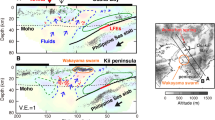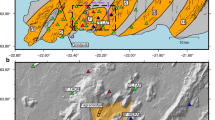Abstract
Beneath Mount Fuji, the highest active volcano in Japan, deep low-frequency (DLF) earthquake activity has been monitored since the early 1980s. The DLF earthquakes occurred in the mid-crustal depth range, and burst-type activity lasting from several minutes to 30 min was detected 10 to 20 times in an ordinary year. The DLF earthquake activity increased sharply in the period from October 2000 to May 2001, showing swarm-like activity. The occurrence rate during the DLF earthquake swarm was approximately 20 times higher than the usual activity, and the wave energy released during the swarm period was twice as high as the total wave energy during the past 20 years. The DLF earthquakes in the period from 1987 to 2001 were relocated by estimating station corrections in order to reduce the effect of the change of seismic station distribution. The epicenters of most DLF earthquakes occurred in an elongated region with a long axis of about 5 km, whose center is located 2–3 km NE from the summit. A few percent of the DLF earthquakes, however, occurred around the summit area, significantly apart from the main epicenter region. The focal depths of well-located DLF events range from 10 to 20 km. During the high activity period in 2000 and 2001, most DLF events occurred within this main hypocenter area. The sharp increase of DLF earthquake activity at Mount Fuji started immediately after magma discharge and intrusion events in the Miyake-jima and Kozu-shima regions in July and August 2000. The tectonic and volcanic activity changes around the area suggest that the DLF earthquake swarm at Mount Fuji was triggered by the change of state of the deep magmatic system around Mount Fuji.








Similar content being viewed by others
References
Aki k Richards PG (2002) Quantitative seismology, 2nd edn. University Science Books, Sausalito, CA, pp 1s– 700
Archuleta RJ, Cranswick E, Mueller C, Spudich P (1982) Source parameters of the 1980 Mammoth Lakes, California, earthquake sequence. J Geophys Res 87:4595–4607
Crosson RS (1978) Crustal structure modeling of earthquake data, 1.Simultaneous least squares estimation of hypocenter and velocity parameters. J Geophys Res 81:3036–3046
Hamada K, Ohtake M, Okada Y, Matsumura S, Sato H (1985) A high quality digital network for microearthquake and ground tilt observation in the Kanto-Tokai area, Japan. Earthqu Predic Res 3:447–469
Hasegawa A, Yamamoto A (1994) Deep, low-frequency microearthquakes in or around seismic low-velocity zones beneath active volcanoes in northeastern Japan. Tectonophysics 233:233–252
Hill DP (1996) Earthquakes and carbon dioxide beneath Mammoth Mountain, California. Seismolog Res Lett 67:8–13
Geshi N, Shimano T, Chiba T, Nakada S (2002) Caldera collapse during the 2000 eruption of Miyakejima Volcano, Japan. Bull Volcanol 64:55–68
Geographical Survey Institute (2002) Crustal deformation of Mt. Hakone and its surrounding area (in Japanese). Report on Coordinating Committee for Prediction of Volcanic Eruption 80:34–40
Koyama M (1998) Reevaluation of the eruptive history of Fuji volcano, Japan, mainly based on historical documents (in Japanese with English abstract). Bull Volcanol Soc Jpn 43:323–348
Koyanagi RY, Chouet B, Aki K (1987) Origin of volcanic tremor in Hawaii, Part 1, Data from the Hawaiian Volcano Observatory 1969–1985. Volcanism in Hawaii, US Geol Surv Prof Pap 1350:1221–1257
Matsumura S (2003) Spatio-temporal features of the seismicity occurring in the assumed locked area of the next Tokai earthquake (in Japanese with English abstract). Bull Earthqu Res Inst Univ Tokyo 78:269–282
Miyaji N (1988) History of younger Fuji volcano (in Japanese with English abstract). J Geol Soc Jpn 94:433–452
Miyaji N, Endo K, Togashi S, Uesugi Y (1992) Tephrochronological history of Mt. Fuji. 29th IUGG FIELD TRIP C12:75–109
Nakamichi H, Hamaguchi H, Tanaka S, Ueki S, Nishimura T, Hasegawa A (2003) Source mechanisms of deep and intermediate-depth low-frequency earthquakes beneath Iwate volcano, northeastern Japan. Geophys J Int 154:811–828
Nakamichi H, Ukawa M, Sakai S (2004) Precise hypocenter locations of midcrustal low-frequency earthquakes beneath Mt. Fuji, Japan. Earth Planet Space, 56:e37–e40
National Research Institute for Earth Science and Disaster Prevention (2002) Low-frequency earthquakes and tilt changes at Mount Fuji (in Japanese). Report on Coordinating Committee for Prediction of Volcanic Eruption 79:95–100
Nishimura T, Ozawa S, Murakami M, Sagiya T, Tada T, Kaidzu M, Ukawa M (2001) Crustal deformation caused by magma migration in the northern Izu Islands, Japan. Geophys Res Lett 28:3745–3748
Ozawa S, Murakami M, Kaidzu M, Tada T, Sagiya T, Hatanaka Y, Yarai H, Nishimura T (2002) Detection and monitoring of ongoing aseismic slip in the Tokai region, central Japan. Science 298:1009–1012
Sakai S, Yamada T, Ide S, Mochizuki M, Shiobara H, Urabe T, Hirata N, Shinohara M, Kanazawa T, Nishizawa A, Fujie G, Mikada H (2001) Magma migration from the point of view of seismic activity in the volcanism of Miyake-jima Island in 2000 (in Japanese with English abstract). J Geogr 110:145–155
Ueda H, Yamamoto E, Ohkubo T, Murakami M, Ueno H, Uhira K (2003) Tensile fault model of the crustal deformation associated with earthquake swarm in the eastern Izu Peninsula in May 2002 (in Japanese with English abstract). Bull Volcanol Soc Jpn 48:471–477
Ueda H, Fujita E, Ukawa M, Yamamoto E, Irwan I, Kimata F (2005) Magma intrusion and discharge process at the initial stage of the 2000 activity of Miyakejima, central Japan, inferred from tilt and GPS data (in press)
Ukawa M, Obara K (1994) Low-frequency earthquakes around Moho beneath the volcanic front in the Kanto district, central Japan (in Japanese with English abstract). Bull Volcanol Soc Jpn 38:187–197
Ukawa M, Ohtake M (1984) Peculiar microearthquake activity just beneath Mt. Fuji (in Japanese with English abstract). J Seismol Soc Jpn 37:129–133
Ukawa M, Ohtake M (1987) A monochromatic earthquake suggesting deep-seated magmatic activity beneath the Izu-Ooshima volcano, Japan. J Geophys Res 92:12649–12663
Ukawa M, Ishida M, Matsumura S, Kasahara K (1984) Hypocenter determination method of the Kanto-Tokai observation network for microearthquakes (in Japanese with English abstract). Res Note Natl Res Cent Disaster Prevent 53:1–88
Ukawa M, Eguchi T, Fuijnawa Y (1988) Seismic activity in the subducting Philippine Sea plate along the Suruga trough revealed by OBS observation. J Phys Earth 36:69–87
Ukawa M, Fujita E, Yamamoto E, Okada Y, Kikuchi M (2000) The 2000 Miyakejima eruption: Crustal deformation and earthquakes observed by the NIED Miyakejima observation network. Earth Planet Space, 52:xix–xxvi
White RA (1996) Precursory deep long-period earthquakes at Mount Pinatubo: spatio-temporal link to basaltic trigger. In: Newhall CG, Punongbayang RS (eds) Fire and mud: eruptions and lahars of Mount Pinatubo, Philippines. University of Washington Press, Seattle, Washington, pp 307–326
Acknowledgements
I would like to thank my colleagues in NIED. Eisuke Fujita helped with data processing of the Mount Fuji observations, Hideki Ueda provided programs to calculate crustal stress changes and Masae Kikuchi provided programs to plot hypocenters. Haruhisa Nakamichi and Sadato Ueki kindly permitted me to use their program for plotting a diamond diagram. Masakazu Ohtake, Yoshimitu Okada, Fumio Yamamizu, Shin-ichi Noguchi and Kazushige Obara helped to construct the Mount Fuji observation network during the initial stage in 1980s. I also wish to thank John Stix, Randall A. White and Minoru Takeo for their helpful comments and suggestions
Author information
Authors and Affiliations
Corresponding author
Additional information
Editorial responsibility: J Stix
Rights and permissions
About this article
Cite this article
Ukawa, M. Deep low-frequency earthquake swarm in the mid crust beneath Mount Fuji (Japan) in 2000 and 2001. Bull Volcanol 68, 47–56 (2005). https://doi.org/10.1007/s00445-005-0419-5
Received:
Accepted:
Published:
Issue Date:
DOI: https://doi.org/10.1007/s00445-005-0419-5




